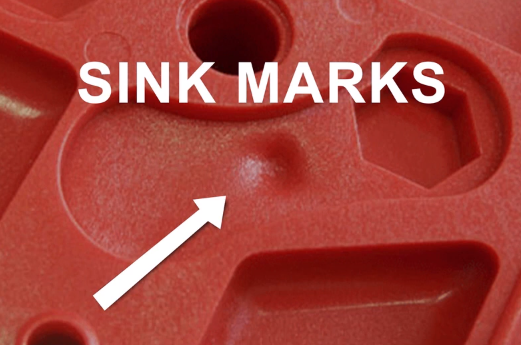There’s a variety of defects that could potentially affect a molded part include short shot, burning, weld line, warpage, peeliing, parting line, sink mark and more. Today’s focus is going to be on one of the most common injection molding defects – Sink Marks which primarily is more of a surface quality issue but depending on the application. We detail the sink marks in plastic injection mold, what causes sink marks and how to avoid sink marks in your plastic injection mold production.

What Are Sink Marks In Plastic Injection Mold?
A sink mark is usually some kind of depression on the surface of the part due to the shrinkage of the material underneath. Sink marks most commonly occur on a surface that has ribs, bosses, and other voluminous features on the rear side of the moulding. All plastics shrink as they freeze off, some more than others. One of the things you can do during the design phase is to identify where these injection molding sink marks are going to be and choose a material that doesn’t shrink as much. Or you can even add something to the material like glass fibers or you can put talcum powder in and it will mitigate the shrinkage quite a bit.
What Causes Sink Marks And How To Fix Them?
1. Improper control of molding conditions
● If the depression and shrinkage mark occur near the gate, it can be solved by prolonging the holding time. The cooling time of the plastic part in the mold should be prolonged when the plastic part has a depression at the wall thickness.
● If the local shrinkage of melt around the insert results in depression and shrinkage mark, which is mainly caused by the low temperature of the insert, it is necessary to increase the temperature of the insert.
● If the nozzle hole of the injection molding machine is too small or the nozzle is locally blocked, the local loss of injection pressure will also cause depression and shrinkage marks. Therefore, the nozzle should be replaced or cleaned.
● If the surface depression of plastic parts is caused by insufficient feeding, the feeding amount should be increased.
In addition, the cooling of the plastic parts in the mold must be sufficient. On the one hand, the melt temperature can be appropriately reduced by adjusting the barrel temperature. On the other hand, the setting of the mold cooling system can be changed to reduce the cooling water temperature, or on the premise of keeping the die surface and all parts of the die evenly cooled, the concave parts can be properly cooled.
2. Mold defects
● If sink marks occur far away from the gate, it is generally due to poor flow of melt in a certain part of the mold structure, which hinders pressure transmission. In this regard, the structural size of the mold gating system should be appropriately expanded, especially for the “bottleneck” that hinders the flow of the melt, the sprue section must be increased, and it is best to extend the sprue to the recessed part.
● For thick-walled plastic injection molded parts, wing gates should be preferred. In this way, for plastic injection molding parts that are not suitable for setting the gate directly on the plastic part and are likely to cause residual deformation at the gate after molding, a wing-shaped body can be attached to the plastic part, and then the gate can be set on the small wing. The gates on the winglets can be inverted gates and point gates, thereby transferring the concave defects of the plastic part to the winglets, and the winglets are cut off after the plastic part is formed.
3. The raw material does not meet the molding requirements
If the shrinkage rate of the molding material is too large or the flow performance is too poor, and the lubricant in the raw material is insufficient or the raw material is wet, the surface of the plastic injection molding part will produce depression and shrinkage marks. Therefore, for the plastic parts with high surface requirements, low shrinkage resin grade should be selected as far as possible.
4.The structure design of the plastic injection molded part is unreasonable
If the wall thicknesses of the plastic parts vary greatly, the thick-walled parts are prone to dents and sink marks due to insufficient pressure during molding. Therefore, when designing the shape and structure of injection molding parts, the wall thickness should be as consistent as possible. For special cases, if the wall thickness of the plastic part is different, it can be solved by adjusting the structural parameters of the gating system.
Conclusion
Anyway, there are a number of things that we can do to reduce injection molding sink mark defect: Maintain consistent wall thickness wherever possible, especially with adjacent walls or features that are on the other side of the part. Tooling engineers can build more cooling channels in critical areas. Process engineers can balance injection moulding pressure, temperature and cooling times to reduce sink marks. Sink marks can be somewhat disguised with darker colors, matte finish and rough surface textures.
